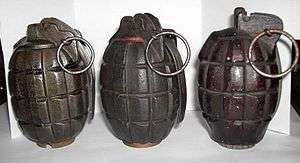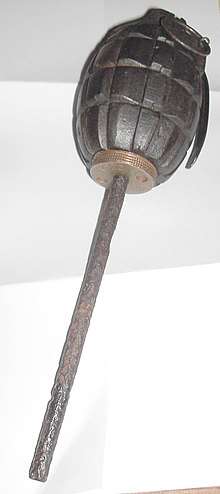Mills bomb
| Mills bomb | |
|---|---|
 Mills bombs. From left to right : No. 5, No. 23, No. 36 | |
| Type | Hand grenade |
| Place of origin | United Kingdom |
| Service history | |
| In service | 1915–1980s |
| Production history | |
| Designed | 1915 |
| No. built | over 70 million |
| Variants | No. 5; No. 23 mk I, II and III; No. 36 mk I; No. 36M mk I; No. 36 mk II |
| Specifications | |
| Weight | 765 g (1 lb 11.0 oz) |
| Length | 95.2mm |
| Diameter | 61 mm (2.4 in) |
|
| |
| Filling | Baratol |
Detonation mechanism | Percussion cap and time delay fuse: 7 seconds, later reduced to 4 |
"Mills bomb" is the popular name for a series of prominent British hand grenades. They were the first modern fragmentation grenades used by the British Army and saw widespread use in World War I.
Overview
William Mills, a hand grenade designer from Sunderland, patented, developed and manufactured the "Mills bomb" at the Mills Munition Factory in Birmingham, England, in 1915.[1] The Mills bomb was inspired by an earlier design by Belgian captain Leon Roland. Roland and Mills were later engaged in a patent lawsuit.[2] Col. Arthur Morrow, a New Zealand Wars officer, also believed aspects of his patent were incorporated into the Mills Bomb[3]. The Mills bomb was adopted by the British Army as its standard hand grenade in 1915, and designated the No. 5.[4]
The Mills bomb underwent numerous modifications. The No. 23 was a variant of the No. 5 with a rodded base plug which allowed it to be fired from a rifle. This concept evolved further with the No. 36, a variant with a detachable base plate to allow use with a rifle discharger cup. The final variation of the Mills bomb, the No. 36M, was specially designed and waterproofed with shellac[4] for use initially in the hot climate of Mesopotamia in 1917, but remained in production for many years. By 1918 the No. 5 and No. 23 were declared obsolete and the No. 36 (but not the 36M) followed in 1932.
The Mills was a classic design; a grooved cast iron "pineapple" with a central striker held by a close hand lever and secured with a pin. According to Mills's notes, the casing was grooved to make it easier to grip and not as an aid to fragmentation, and in practice it has been demonstrated that it does not shatter along the segmented lines. The Mills was a defensive grenade (meant to be thrown from behind cover at a target in the open, wounding with fragmentation, as opposed to an offensive grenade, which doesn't fragment, relying on short-ranged blast effect to wound or stun enemy troops without endangering the exposed thrower with fragments, which travel a much longer distance than blast alone. With fragmenting defensive grenades, after throwing the user had to take cover immediately (however, in spite of the designations, "defensive" grenades were frequently used offensively, and vice versa. A competent thrower could manage 15 metres (49 feet) with reasonable accuracy, but the grenade could throw lethal fragments farther than this. The British Home Guard were instructed that the throwing range of the No. 36 was about 30 yards with a danger area of about 100 yds.[5]
At first the grenade was fitted with a seven-second fuse, but during combat in the Battle of France in 1940 this delay proved to be too long, giving defenders time to escape the explosion, or even to throw the grenade back, and was reduced to four seconds.
The heavy segmented bodies of "pineapple" type grenades result in an unpredictable pattern of fragmentation. After the Second World War Britain adopted grenades that contained segmented coiled wire in smooth metal casings. The No. 36M Mk.I remained the standard grenade of the British Armed Forces and was manufactured in the UK until 1972, when it was completely replaced by the L2 series. The 36M remained in service in some parts of the world such as India and Pakistan, where it was manufactured until the early 1980s. Mills bombs were still being used in combat as recently as 2004 e.g. the incident which killed US Marine Jason Dunham and wounded two of his comrades.[6]
Models
- The No. 5 Mk. 1 was the first version. The explosive was filled through a small circular plug on the upper half, the detonator assembly was inserted into the centertube of the mills through the bottom of the grenade body via the baseplug, the striker and spring is held in tension through the middle by the lever that was held down on the lugs (ears) located on the top of the grenade body via a split pin and ring called the safety pin/ pullring. It was first issued in May 1915 and entered general issue when mass production caught up a year later in 1916.
- The No. 23 Mk. 1, the hand/ rifle-grenade ' had a baseplug drilled with a threaded hole for a rifle launching rod . The No. 23 Mk.II had a new style iron baseplug that was easier to tighten with the fingers without the need for a spanner.the No. 23 MkIII was a new style body with a larger filler hole plug and more solid lever lugs/ears but retaining the MkII style plug.
- The No. 36 Mk. 1 was first introduced in May 1918. It used the No. 23 MkIII body but a new style plug. Mostly made of iron and was drilled and threaded for attaching a metal disk called a gas check that made the grenade launchable from a cup discharger (Burns) mounted on a rifles muzzle and launched using a balastite blank cartridge .
- The shellac-coated "Mesopotamian" variant (No. 36M MkI) was designed to keep moisture and humidity out of the detonator's fuse. The No. 36M MkI was the British army's standard hand-grenade from the 1930s to 1972.[7]
Identification marks
- A green band around the middle originally indicated an Amatol filling (1915–1920s), while it later indicated a Baratol or Trotyl filling (1920s–1970s).
- A pink band around the middle indicates an Ammonal or Alumatol filling. (Alumatol is defined by the Dictionary of Explosives, pub 1920[8] as 'a mixture of ammonium nitrate, TNT and 'a small quantity' of aluminium power.) A red band around the base plug on the bottom indicated the detonator was already installed and that the grenade was live.
- Three red Xs along each side indicates that it is the waterproofed No.36M model.
Rifle grenade
The Mills bomb was developed into a rifle grenade by attaching a metallic rod to its base. This rod-type rifle-grenade had an effective range of about 150 yards. The operating procedure was to insert the Mills bomb rod down the barrel of a standard rifle, put a special blank cartridge in the rifle's chamber, place the rifle stock on the ground, then pull the Mills bomb's safety pin, releasing the safety spoon and immediately fire the rifle. If the soldier did not launch the grenade quickly, the grenade's fuse would time out and explode. The British soon developed a simple cradle attached to the rifle's bayonet lug to hold the safety-spoon in place and prevent accidental detonations.[9] However, it was found that the repeated launching of rod-type grenades caused damage to the rifle's barrel, causing the middle to bulge out due to the prolonged pressure spike from driving the much heavier, larger projectile up the barrel (typically a much faster process with a normal bullet); a rifle cartridge rapidly burns up all the available powder, which fills the volume behind the bullet with extremely high pressure gases (tens of thousands of PSI), the pressure rising as the bullet moves up the barrel, peaking at some point before the bullet leaves the muzzle. With the much heavier grenade and rod, the cartridge had to accelerate a much heavier mass, which resulted in the powder burning up and the pressure peaking before the rod had gotten more than a part of the way up the barrel, putting peak pressure on sooner and sustaining it for longer.
The British subsequently developed a cup-type launcher to replace the rod-type rifle-grenade. In this design, a can-shaped launcher was attached to the muzzle of the rifle and a gas check disc was screwed onto the base of the grenade before the grenade was placed in the launcher. The safety pin could then be removed as the launcher cup kept the safety-spoon in place. The operator inserted the blank cartridge into the rifle before setting the stock, angled on the ground to absorb the recoil of the weapon. When the cartridge was fired it pushed the grenade out of the cup releasing the spoon. The cup-type launcher could launch the grenade about 200 yards. Lee–Enfield rifles equipped with the cup launcher were modified with copper wire wrapped around the stock, to prevent the wood from cracking under the increased recoil. If necessary, both the rod and the gas check grenade could be thrown as a standard hand-grenade.
Gallery
 No. 5 Mk II Mills bomb
No. 5 Mk II Mills bomb Cutaway view of a No. 5 Mills bomb
Cutaway view of a No. 5 Mills bomb No. 23 Mk II Mills bomb
No. 23 Mk II Mills bomb- 36M grenade dated 1940
- Base of 36M grenade dated 1940
 36M Mills bomb
36M Mills bomb Mills bomb No. 23 Mk II, with rod for launch by rifle
Mills bomb No. 23 Mk II, with rod for launch by rifle Drawing of the Mills No. 36 rifle grenade, with its gascheck disk for use with cup-launcher
Drawing of the Mills No. 36 rifle grenade, with its gascheck disk for use with cup-launcher- Lee-Enfield cup-launcher in the 1916 Somme Battlefield Museum, France
 A case of derived type with special base plug
A case of derived type with special base plug
See also
References
- ↑ U.S. Patent 1,178,092 U.S. copy of the 1915/1916 Mills grenade patent
- ↑ G. D. Sheffield (2007). War on the Western Front. Osprey Publishing. p. 196. ISBN 978-1-84603-210-3.
- ↑ "Patent by Arthur Morrow for "Improvement in projectiles", dated 2 November 1893". Auckland Museum Catalogue. Retrieved 5 March 2018.
- 1 2 "www.firstworldwar.com - Who's Who - Sir William Mills".
- ↑ Capt. A. Southworth, M.B.E (1944)Home Guard Pocket Manual p47
- ↑ "Cpl Jason Dunham". Usmcronbo.tripod.com. Retrieved 23 October 2012.
- ↑ Bernard Plumier. "Passion & Compassion 1914-1918 : WW1 militaria and technical documentation - english grenades". passioncompassion1418.com.
- ↑ Marshall, Arthur (1920). Dictionary of Explosives. Philadelphia, USA: Blakiston.
- ↑ Inert-Ord.Net, Copyright 2001-2005. "British Mills No.23 Rod Grenade - Inert-Ord.Net". Retrieved 5 September 2016.
External links
| Wikimedia Commons has media related to Mills bomb. |